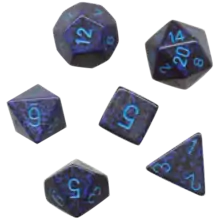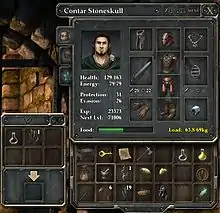Player character
A player character (also known as PC and playable character) is a fictional character in a video game or tabletop role-playing game whose actions are directly controlled by a player of the game rather than the rules of the game. The characters that are not controlled by a player are called non-player characters (NPCs). The actions of non-player characters are typically handled by the game itself in video games, or according to rules followed by a gamemaster refereeing tabletop role-playing games. The player character functions as a fictional, alternate body for the player controlling the character.[1][2][3]
| Part of a series on |
| Role-playing games |
|---|
 |
| Types |
| Topics |
| Lists |
|
|

Video games typically have one player character for each person playing the game. Some games, such as multiplayer online battle arena, hero shooter and fighting games, offer a group of player characters for the player to choose from, allowing the player to control one of them at a time. Where more than one player character is available, the characters may have different abilities, strengths, and weaknesses to make the game play style different.
Overview
Avatars
A player character may sometimes be based on a real person, especially in sports games that use the names and likenesses of real athletes. Historical figures and leaders may sometimes appear as characters too, particularly in strategy or empire building games such as in Sid Meier's Civilization series. Such a player character is more properly an avatar as the player character's name and image typically have little bearing on the game itself. Avatars are also commonly seen in casino game simulations.
Blank characters
In many video games, and especially first-person shooters, the player character is a "blank slate" without any notable characteristics or even backstory. Pac-Man, Crono, Link and Chell are examples of such characters. These characters are generally silent protagonists.
Some games will go even further, never showing or naming the player-character at all. This is somewhat common in first-person videogames, such as in Myst, but is more often done in strategy video games such as Dune 2000, Emperor: Battle for Dune, and Command & Conquer series. In such games, the only real indication that the player has a character (instead of an omnipresent status), is from the cutscenes during which the character is being given a mission briefing or debriefing; the player is usually addressed as "general", "commander", or another military rank.
In gaming culture, such a character was called Ageless, Faceless, Gender-Neutral, Culturally Ambiguous Adventure Person, abbreviated as AFGNCAAP; a term that originated in Zork: Grand Inquisitor where it is used satirically to refer to the player.[4]
Role-playing games
In role playing games such as Dungeons & Dragons or Final Fantasy, a player typically creates or takes on the identity of a character that may have nothing in common with the player. The character is often of a certain (usually fictional) race and class (such as zombie, berserker, rifleman, elf, or cleric), each with strengths and weaknesses. The attributes of the characters (such as magic and fighting ability) are given as numerical values which can be increased as the gamer progresses and gains rank and experience points through accomplishing goals or fighting enemies.
Fighting games
Fighting games typically have a larger number of player characters to choose from, with some basic moves available to all or most characters and some unique moves only available to one or a few characters. Having many different characters to play as and against, all possessing different moves and abilities, is necessary to create a larger gameplay variety in such games.
Multiplayer online battle arena
Multiplayer online battle arena (MOBA) games offer a large group of viable player characters for the player to choose from, each of which having different abilities, strengths, and weaknesses to make the game play style different. Choosing a character who complements player's teammates and counters his opponents, opens up a strategy before the beginning of the match itself.[5] Playable characters blend a variety of fantasy tropes, featuring numerous references to popular culture and mythology.[6][7][8]
Hero shooters
Similarly to MOBAs, hero shooters emphasize pre-designed "hero" characters with unique abilities and weapons that are not available to the other characters.[9] Hero shooters strongly encourage teamwork between players on a team, guiding players to select effective combinations of hero characters and coordinate the use of hero abilities during a match.[10]
Secret characters
A secret or unlockable character is a playable character in a video game available only after either completing the game or meeting another requirement. In some video games, characters that are not secret but appear only as non-player characters like bosses or enemies become playable characters after completing certain requirements, or sometimes cheating.
References
- La Farge, Paul (September 2006). "Destroy All Monsters". The Believer Magazine. Archived from the original on 2008-09-20. Retrieved 2008-12-25.
- TSR Hobbies, Understanding Dungeons & Dragons, 1979. Quoted in Gary Alan Fine, Shared Fantasy: Role-Playing Games as Social Worlds (Chicago: U Chicago Press, 1983)
- Waggoner, Zack (2009). My Avatar, My Self: Identity in Video Role-Playing Games. University of Michigan. p. 8. ISBN 978-0-7864-4109-9. Retrieved 2014-11-12.
- Douglas, Jeremy (December 2007). Command Lines: Aesthetics and Technique in Interactive Fiction and New Media. p. 199. ISBN 9780549363354. Retrieved 2014-11-12.
- Crider, Michael. "Why Are MOBA Games like League of Legends So Popular?". How-To Geek. Retrieved 2020-07-17.
- Marshall, Cass (2019-12-05). "Riot's new games are League of Legends' best asset (and biggest threat)". Polygon. Retrieved 2020-09-07.
Now it has lore that’s legitimately worth reading, in a collection of genres ranging from Lovecraftian horror to knights and banners fantasy to pirate power struggles.
- "Blizzard's Worlds Collide When Heroes of the Storm™ Launches June 2". www.businesswire.com. 2015-04-20. Retrieved 2020-09-07.
The free-to-play online team brawler brings together a diverse cast of iconic characters from Blizzard’s far-flung realms of science fiction and fantasy
- "The making of a Smite god: from mythology to main stage". PCGamesN. Retrieved 2020-09-07.
Obviously we’re a game about mythology, so one of the things we look for is a mythological character that would be good to bring into the game
- Wood, Austin (2016-10-25). "What the strange evolution of the hero shooter tells us about the genre's future". PC Gamer. Retrieved 2021-01-15.
- Wawro, Alex. "Hero Shooters: Charting the (re)birth of a genre". www.gamasutra.com. Retrieved 2021-01-15.